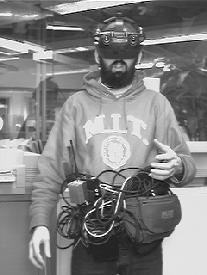 |
Dolezal [16] (page 19) describes ``various types of optical transformations'', such as the inversion explored by Stratton, as well as displacement, reversal, tilt, magnification, and scrambling. Kohler [17] also discusses ``transformation of the perceptual world''.
Stratton, Dolezal, and Kohler explored the use of optics (lenses, prisms, and the like). Stuart Anstis was the first to explore, in detail, an electronically mediated world. Anstis [18], using a camcorder that had a ``negation'' switch on the viewfinder, experimented with living in a ``negated'' world. He walked around holding the camcorder up to one eye, looking through it, and observed that he was unable to learn to recognize faces in a negated world. His negation experiment bore a similarity to Stratton's inversion experiment mentioned in Sec 2.1, but the important difference within the context of this article is that Anstis electronically mediated his visual world -- he experienced his world as a video signal.
Using a camcorder as a reality mediator has several drawbacks. Firstly, it is awkward (one hand is occupied constantly, and the apparatus protrudes far enough that it gets in the way of most day-to-day activities), and secondly, it makes people feel much more self-conscious Thirdly, it is not easy to insert arbitrary computational power between the camera and the viewfinder.
WearCam provided a practical solution to these three problems, by
serving as a wearable, tetherless
`reality mediator'. A suitable realization
of WearCam, made from a battery-powered
color stereo display, having 480 lines of resolution,
is depicted in
Fig 2.
 |
Although the apparatus provided no depth-from-focus capability there was enough depth perception remaining on account of the stereo disparity for the author to function somewhat normally with the apparatus.
The use of head-mounted displays for helping the visually handicapped, using the contrast adjustments of the video display to increase apparent scene contrast has been recently explored[19], but without the use of computational processing of the imagery. The approach described in this paper (Fig 2) also contains computational capability, and therefore extends and generalizes that recently described in [19].
A first step in using the wearable-tetherless reality mediator was to wear it for a while to become accustomed to its characteristics. Unlike in typical beam-splitter implementations of augmented reality, transparency, if desired, is synthesized, and therefore only as good as the components used to make the apparatus.
The apparatus was worn in the identity map configuration (cameras connected directly to the displays) for several days, in order to adapt to its imperfections and irregularities (the identity map is never fully achieved). It was found that one could easily walk around, up and down stairs, through doorways, etc.. Some difficulties, however, were experienced, in scenes of high dynamic range, and also in reading fine print (for example, in a restaurant, where the menu was located behind a counter, preventing a close-up look, or in a department store, where the receipt was printed in faint ink).
The attempt to create an illusion of transparency was itself a useful experiment because it established some working knowledge of what can be performed when vision is diminished or degraded to RS170 resolution and field of view is somewhat limited by the apparatus.